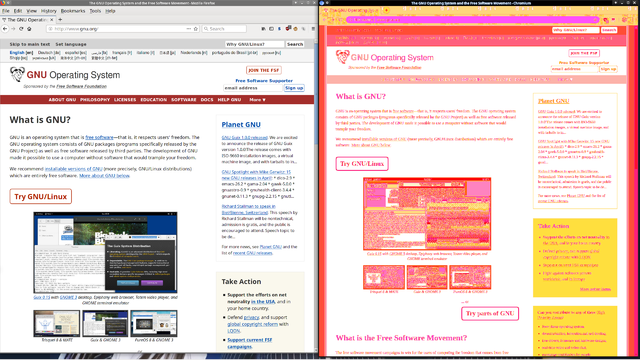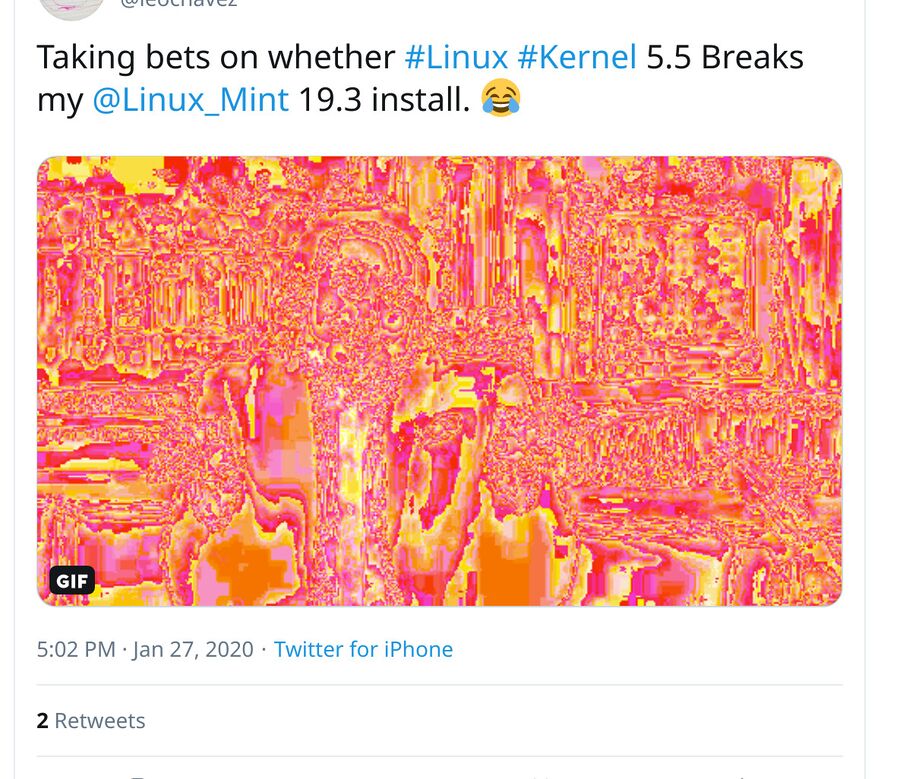AMD graphics
AMD graphics cards and APUs are generally very well supported by GNU/Linux distributions. The vast majority will work fine out of the box. Some older AMD cards require special kernel parameters to enable features like Vulkan support. Screen tearing can be a problem in setups. That can problem be fixed using a X configuration file if it is an issue.
Overview[edit]
| Family | GFX core | Display Core | ISA | Code-name | Brands | OpenGL | Vulkan | OpenCL |
|---|---|---|---|---|---|---|---|---|
| R600 | GFX3 | DCE 2 | VLIW5 | R600, RV610, RV630, RV620, RV635, RV670, RS780, RS880 | HD2400 - HD4290 | |||
| R700 | GFX3 | VLIW5 | DCE 3.1 | RV770 | HD4330 - HD5165, HD5xxV | |||
| DCE 3.2 | RV710, RV730, RV740 | |||||||
| Evergreen | GFX4 | VLIW5 | DCE 4 | CEDAR, REDWOOD, JUNIPER, CYPRESS | HD5430 - HD5970, all HD6000 not listed under Northern Islands, HD7350 | |||
| DCE 4.1 | PALM (Wrestler/Ontario), SUMO (Llano), SUMO2 (Llano) | |||||||
| Northern Islands | GFX5 | VLIW4 | DCE 5 | BARTS, TURKS, CAICOS, CAYMAN | HD6450, HD6570, HD6670, HD6790 - HD6990, HD64xxM, HD67xxM, HD69xxM, HD7450 - HD7670 | |||
| DCE 5.1 | ARUBA (Trinity/Richland), | |||||||
| Southern Islands | GFX6 | GCN 1 | DCE 6 | CAPE VERDE, PITCAIRN, TAHITI, | HD7750 - HD7970,
R9 270, R9-280, R7 240, R7 250, HD 8000M-series, R5 330-R7 350, FirePro W600, FirePro W4100 FirePro W5000, FirePro W7000, FirePro W8000, FirePro W9000 |
|||
| DCE 6.4 | OLAND, HAINAN | |||||||
| Sea Islands | GFX7 | GCN | DCE 8.1 | KAVERI | HD7790, R7 260, R9 290, R9 295X2, R9 290X, FirePro W2100, FirePro W5100, FirePro W8100, FirePro W9100, FirePro W4300 | |||
| DCE 8.2 | BONAIRE | |||||||
| DCE 8.3 | KABINI, MULLINS | |||||||
| DCE 8.5 | HAWAII | (ROCm) | ||||||
| Volcanic Islands | GFX8 | GCN | DCE 10 | TONGA FIJI | R9 285, R9 380, R9 Nano, R9 Fury X, FirePro W7100 | |||
| DCE 11 | CARRIZO, STONEY, ICELAND/TOPAZ | |||||||
| DCE 11.2 | POLARIS10, POLARIS11, POLARIS12, VEGAM | RX 460-480, RX 560-590 | (ROCm) | |||||
| Vega | GFX9 | GCN 5 | DCE 12.0 | VEGA10, VEGA12 | Vega 3, 6, 8, RX Vega 10-11, RX Vega 56, RX Vega 64, Radeon VII | |||
| DCE 12.1 | VEGA20 | |||||||
| DCN 1.0 | RAVEN | Athlon 200GE-240GE, Athlon 3000G, Ryzen 3 2200G, Ryzen 5 2400G | ||||||
| ARCTURUS[1] | ||||||||
| DCN 2.1 | RENOIR | Ryzen 3 4300G & 4350G, Ryzen 5 4600 & 4650G, Ryzen 7 4700G & 4750G | ||||||
| Navi | GFX10 | RDNA | DCN 2.0 | NAVI10, NAVI12, NAVI14 | ||||
| GFX10.3[2] | RDNA2 | DCN 3.0[3] | ||||||
| Vangogh[6] | GFX10.3[2] | RDNA2 | DCN 3.0 | Vangogh |
GNU/Linux Support[edit]
There are two kernel modules for AMD graphics cards: radeon and ampgpu. Really old cards can only use radeon. All fairly recent (2010+) cards can use the amdgpu driver
Vulkan is supported on all GCN cards when using the amdgpu kernel driver. The deprecated radeon kernel driver can't into Vulkan.
Support for hardware video decoding on older GCN gen one and two cards (Southern Islands) with the amdgpu driver did not arrive until Linux 5.9. Those with older AND graphics cards will have to choose between hardware video decoding OR Vulkan support if they use an earlier kernel.
User-space support for OpenGL and Vulkan are provided by the Mesa graphics library. The radeonsi driver provides OpenGL 4.6 support and the RADV driver provides Vulkan 1.2 support.
Hardware Video Decoding / Encoding[edit]
Applications like OBS Studio, Jellyfin, mpv and other video video software can use VAAPI to utilize the hardware video decoding and encoding capabilities on AMD hardware. You need the libva library to make it work. The vainfo tool from the libva-utils package can tell you what your hardware does and does not support.
| ARUBA (Trinity/Richland), TAHITI | CAPE VERDE, PITCAIRN, OLAND | KAVERI, KABINI, MULLINS, BONAIRE, HAWAII | TONGA, FIJI | CARRIZO | STONEY | POLARIS10, POLARIS11, POLARIS12, VEGAM | VEGA10, VEGA12 | VEGA20 | RAVEN | NAVI10, NAVI14, RENOIR | |
|---|---|---|---|---|---|---|---|---|---|---|---|
| Decoder Hardware |
UVD3.2 | UVD4.0 | UVD4.2 | UVD5.0 | UVD6.0 | UVD6.2 | UVD6.3 | UVD7.0 | UVD7.2 | VCN1.0 | VCN2.0 |
| Encoder Hardware |
VCE1.0 | VCE2.0 | VCE3.0 | VCE3.1 | VCE3.4 | VCE3.4 | VCE4.1 | VCE4.2 | VCN1.0 | VCN2.0 | |
| MPEG-2 | |||||||||||
| H264/MPEG-AVC | |||||||||||
| VC-1 | |||||||||||
| JPEG | |||||||||||
| VP8 | |||||||||||
| HEVC | |||||||||||
| HEVC 10-bit | |||||||||||
| HEVC 12-bit | |||||||||||
| VP9 | |||||||||||
| VP9 10-bit | |||||||||||
| VP9 12-bit | |||||||||||
| AV1 | |||||||||||
| EVC | |||||||||||
| VVC | |||||||||||
HOWTOs[edit]
Choosing The "Right" Kernel Driver[edit]
You will not have to care in the vast majority of cases, amdgpu is the right choice for all newer graphics cards and the kernel will choose that automatically. There are two generations of olders AMD graphics cards and APUs where amdgpu is optional and radeon is the default: "Southern Islands" and "Sea Islands".
"Southern Islands" is a special case where hardware video decoding will only work with radeon in kernels prior to 5.9 while Vulkan will only work if amdgpu is used. Linux 5.9+ supports both on "Southern Islands" cards.
Which you kernel prefer can be selected by using kernel boot parameters OR a module configuration file /etc/modprobe.d/amdgpu.conf
| Graphics Card Family | Names | APUs/GPUs | parameters forcing amdgpu
| |
|---|---|---|---|---|
| kernel | amdgpu.conf | |||
| Southern Islands | CAPE VERDE, PITCAIRN, TAHITI, OLAND, HAINAN |
HD7750-HD7970, HD8550M-HD8790M R9 270, R7 240, R7 250, R9-280, R9 370X |
radeon.si_support=0 amdgpu.si_support=1 | options radeon si_support=0 options amdgpu si_support=1 |
| Sea Islands | BONAIRE, KABINI, MULLINS, KAVERI, HAWAII |
HD7790, HD8180-HD8400 R7 260, R9 290 AMD E1-6010, Athlon 5350, ++ |
radeon.cik_support=0 amdgpu.cik_support=1 | options radeon cik_support=0 options amdgpu cik_support=1 |
The x.org Feature Matrix for Free Radeon Drivers page has a list of code-names for AMD graphics chips.
Avoiding Screen Tearing[edit]
Screen tearing can generally be avoided by using a compositing window manager. That does not solve tearing when a display is rotated and it does not solve tearing when the display manager is not doing compositing. Compositing does have a performance overhead which is significant on older APUs.
Both the amdgpu[7] and the radeon[8] drivers support an option called TearFree. Add either of these configuration files to a /etc/X11/xorg.conf.d/ folder (will exist on most distributions but you have to created it on Ubuntu and a few others):
Section "Device" Identifier "AMD Graphics" Driver "amdgpu" Option "TearFree" "true" EndSection
If you're using something rather old like a HD7850 you're using the "radeon" driver and you need:
Section "Device" Identifier "AMD Graphics" Driver "radeon" Option "TearFree" "true" EndSection
Overclocking[edit]
See HOWTO undervolt the AMD RX 4XX and RX 5XX GPUs. It includes information on overclocking.
Enabling The Experimental ACO Shader Compiler[edit]
Mesa 20 has a ACO shader compiler for Vulkan which is faster than the default LLVM shader compiler. You can enable it by setting export RADV_PERFTEST=aco
ACO is enabled by default in Mesa 20.2.0 and newer. You do NOT need to do anything to enable it on Mesa 20.2+. Force-enabling ACO on Mesa 20.2 produces a informative message telling you that it is the default.
Unlocking Manual Control Over Power Features[edit]
 |
Warning: You should not do this unless you know what you are doing. And you don't.
We realize that you will do it anyway. That's fine, it's your machine. Don't forget that we tried to warn you and you didn't listen if something bad happens. |
The secret amdgpu.ppfeaturemask amdgpu module parameter can be (ab)used to unlock full control over features AMD won't let you have by default. This should be added to either a module configuration file like /etc/modprobe.d/80-amdgpu.conf with
options amdgpu ppfeaturemask=0xffffffff
or to the kernel command line as a boot parameter in the GRUB_CMDLINE_LINUX= variable in /etc/sysconfig/grub that says:
amdgpu.ppfeaturemask=0xffffffff
The 0xffffffff value unlocks everything. You do not need to unlock everything, ppfeaturemask supports several other values. amd_shared.h[9] story as of Linux git September 2020 is:
enum PP_FEATURE_MASK {
PP_SCLK_DPM_MASK = 0x1,
PP_MCLK_DPM_MASK = 0x2,
PP_PCIE_DPM_MASK = 0x4,
PP_SCLK_DEEP_SLEEP_MASK = 0x8,
PP_POWER_CONTAINMENT_MASK = 0x10,
PP_UVD_HANDSHAKE_MASK = 0x20,
PP_SMC_VOLTAGE_CONTROL_MASK = 0x40,
PP_VBI_TIME_SUPPORT_MASK = 0x80,
PP_ULV_MASK = 0x100,
PP_ENABLE_GFX_CG_THRU_SMU = 0x200,
PP_CLOCK_STRETCH_MASK = 0x400,
PP_OD_FUZZY_FAN_CONTROL_MASK = 0x800,
PP_SOCCLK_DPM_MASK = 0x1000,
PP_DCEFCLK_DPM_MASK = 0x2000,
PP_OVERDRIVE_MASK = 0x4000,
PP_GFXOFF_MASK = 0x8000,
PP_ACG_MASK = 0x10000,
PP_STUTTER_MODE = 0x20000,
PP_AVFS_MASK = 0x40000,
};
You can, in other words, use ppfeaturemask to enable control over just a few features or a single feature like PP_STUTTER_MODE if you want your games to stutter.
| Confusing name | Default | Deconfuse |
|---|---|---|
| PP_STUTTER_MODE | Disabled. | Enable stutter mode can save power in low DRAM use cases including but not limited to productivity application use, web browsing, and video playback. |
| Thank you to Remco for providing details. | ||
Troubleshooting[edit]
IOTLB_INV_TIMEOUT on AMD Radeon Pro W5700 (and others) when IOMMU is enabled[edit]
Some less common AMD graphics fail to work when IOMMU is enabled. The kernels ring buffer will say something like:
[ 3.375841] iommu ivhd0: AMD-Vi: Event logged [IOTLB_INV_TIMEOUT device=63:00.0 address=0x42b5b01a0] [ 3.375845] iommu ivhd0: AMD-Vi: Event logged [IOTLB_INV_TIMEOUT device=63:00.0 address=0x42b5b01c0]
if you are affected by this particular problem. A working solution is to add pci=noats to the kernel command line.
Totally Messed Up Colors In Some Applications[edit]
Some software, primarily the Chromium web browser, has issues with 10-bit colors. Chromium will look all messed up if you enable 10-bit color:

The Chromium browser on a desktop where 10-bit color is enabled. It is one of the few programs with this particular problem.
This is not only a problem if you enable 10-bit color on your desktop. It is also a problem with Chromium, and perhaps other software, if the Mesa version defaults to 10-bit color on certain GLX and EGL operations[10] (in later Mesa versions). This behavior makes Chromium show videos with all messed up colors[11] if the Chromium browser is built with VAAPI patches for hardware accelerated video playback and the video playback is using this feature.

Chromium playing a video using Mesa 20 and VAAPI for hardware accelerated video playback.
The above video playback problem can be solved by creating a $HOME/.drirc file with the following contents:
<?xml version="1.0" standalone="yes"?>
<driconf>
<!-- Please always enable app-specific workarounds for all drivers and
screens. -->
<device driver="radeonsi">
<application name="Chromium" executable="chromium-freeworld">
<option name="allow_rgb10_configs" value="false"/>
</application>
</device>
<device driver="radeonsi">
<application name="Chromium" executable="chromium-browser">
<option name="allow_rgb10_configs" value="false"/>
</application>
</device>
</driconf>
You can, alternatively, put that in a file in /usr/share/drirc.d to make it system-wide. You can also set allow_rgb10_configs=false in /etc/environment.
Notes[edit]
- ↑ amd/powerplay/amdgpu_smu.c
- ↑ 2.0 2.1 cgit.freedesktop.org/mesa/mesa/tree/src/amd/common/ac_gpu_info.c
- ↑ amd/amdgpu/amdgpu_device.c line 2811, if defined
CONFIG_DRM_AMD_DC_DCN3_0CHIP_SIENNA_CICHLID / CHIP_NAVY_FLOUNDER - ↑ git.kernel.org: amdgpu/gfx_v10_0.c
- ↑ git.kernel.org: sdma_v5_2.c amdgpu/sdma_v5_2.c
- ↑ https://cgit.freedesktop.org/mesa/mesa/tree/src/amd/llvm/ac_llvm_util.c
- ↑ amdgpu manual page
- ↑ radeon manual page
- ↑ git.kernel.org: amd_shared.h
- ↑ fbconfig is not 8 bits RGB with Mesa 18.x or newer
- ↑ Broken VP9 video playback colors on AMD Ryzen 5 (PRO) Mobile 2500U in Chromium

Enable comment auto-refresher